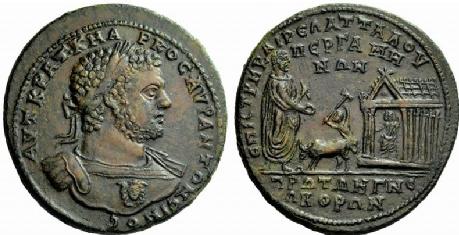All 2 entries tagged Caracalla
No other Warwick Blogs use the tag Caracalla on entries | View entries tagged Caracalla at Technorati | There are no images tagged Caracalla on this blog
October 01, 2013
Caracalla's "Profectio" Coin
 |
| Profectio coin of Caracalla |
In AD 214, the emperor Marcus Aurelius Antoninius Pius, nicknamed Caracalla after the Gallic tunic he allegedly wore, left Rome on a journey throughout the eastern provinces. The word PROFECTIO is used in Latin epigraphy to identify when an emperor sets out from Rome on a military expedition, and this word is seen on the legend on the reverse of this denarius. Minted in AD 213, this coin represents the sense of anticipation faced by Romans before the launching of such a force. Coins minted in the same year depict similar types as the coin we see here, as well as other military images such as the war god Mars. Whoever designed this coin, whether it be Caracalla himself or an imperial mint worker, clearly wanted to expose citizens to this upcoming event months in advance. Thus the coin acts as propaganda, advertising the emperor’s militaristic and proactive qualities.
The “Profectio” concept also gives the sense of beginnings being important in Roman life. The fact that the actual beginning of the expedition, rather than the expedition itself, is commemorated on this coin indicates the Romans considered the start of something to be just as worthy as the event itself. This suggests a sense of supreme confidence, as even before it has set off, the Romans believe this journey to be worthy of monumentalising through the medium of coinage, implying Romans were very optimistic about the success of their emperor and army.
The coin also reinforces the emperor’s own desire to be depicted in a military way. The type on the reverse of the coin displays Caracalla himself in military armour, carrying a spear, and it gives the impression of him personally leading the legions, represented by the standards behind him. This portrayal of himself as a great military leader is reinforced by the appearance of BRIT in the legend on the obverse of the coin, which represents “Britannicus”, or “Conqueror of the Britons”. While this title has been passed down from his father Severus (often done by Roman emperors), Caracalla himself can say he played a part in it, as he joined his father on his conquests. Accounts of the time indicate Caracalla actually played no significant role in his father’s Britannia campaign, but it is something an ordinary Roman would be unaware of. Thus even before his Profectio, Caracalla could identify himself as an experienced conqueror. Such a portrayal was probably designed to inspire support from the army, presenting the emperor as someone worth following, and whose rule they should support. However, this did not help him maintain his rule: whilst returning from his beloved Profectio, having dismounted to empty his bowels, he was murdered by a member of his Praetorian bodyguards close to the city of Edessa in Syria.
This month’s coin was chosen by David Swan, a second year Ancient History and Classical Archaeology undergraduate. David’s research interests involve Celtic, Roman and Dark Age Britain.
(Coin image above reproduced courtesy of Pecunem.com and Gitbud & Naumann)
September 01, 2013
A bronze medallion depicting Caracalla and Asclepius from Pergamum, AD 211–217 (AE 46.14g)
(Coin of the Month February 2013)
In c.AD 214 Caracalla visited the city of  Pergamum as part of his tour around Asia Minor. Ancient historians state that the reason for this visit was because he sought healing and relief from dreams in which he was being chased by his father Septimus Severus and brother Geta, whom he was accused of murdering. As the healing god of antiquity, Asclepius was a logical choice to supplicate for salvation. This medallion is part of a series which was minted by Pergamum in AD 211-217. The series documents the emperor’s advent and his ritual movements through the city. This medallion shows Caracalla supplicating Asclepius in front of his temple. In between the god and the emperor stands a bull waiting to be sacrificed to the god and an attendant with a raised axe. This medallion is especially important as it shows the significance the emperor attached to worshipping Asclepius and the belief that this god could save him from his torment. It also shows the importance the city attached to the emperor’s visit as the polis struck these issues and also issued another series commemorating the visit some years later. This medallion also shows the advantages of imperial benefaction upon a city as the coin’s legend mentions that Pergamum was the first who was ‘three times neokoros’ in Asia Minor. This term was used to indicate a city which had a temple of the imperial cult and Pergamum was the first in the region to have three temples of emperors. Other coins from this series show Asclepius and Caracalla sharing a temple, a practise not uncommon in Asia Minor, again indicating Caracalla’s patronage of this god.
Pergamum as part of his tour around Asia Minor. Ancient historians state that the reason for this visit was because he sought healing and relief from dreams in which he was being chased by his father Septimus Severus and brother Geta, whom he was accused of murdering. As the healing god of antiquity, Asclepius was a logical choice to supplicate for salvation. This medallion is part of a series which was minted by Pergamum in AD 211-217. The series documents the emperor’s advent and his ritual movements through the city. This medallion shows Caracalla supplicating Asclepius in front of his temple. In between the god and the emperor stands a bull waiting to be sacrificed to the god and an attendant with a raised axe. This medallion is especially important as it shows the significance the emperor attached to worshipping Asclepius and the belief that this god could save him from his torment. It also shows the importance the city attached to the emperor’s visit as the polis struck these issues and also issued another series commemorating the visit some years later. This medallion also shows the advantages of imperial benefaction upon a city as the coin’s legend mentions that Pergamum was the first who was ‘three times neokoros’ in Asia Minor. This term was used to indicate a city which had a temple of the imperial cult and Pergamum was the first in the region to have three temples of emperors. Other coins from this series show Asclepius and Caracalla sharing a temple, a practise not uncommon in Asia Minor, again indicating Caracalla’s patronage of this god.
 This month’s coin was chosen by Ghislaine van der Ploeg, a second year PhD student. Ghislaine’s research focusses on the cult of Asclepius and its dissemination. Coins, as well as inscriptions, art, and architecture are vital in this, as each dedication gives a unique perspective on the ways in which the cult spread and the factors which were responsible for this.
This month’s coin was chosen by Ghislaine van der Ploeg, a second year PhD student. Ghislaine’s research focusses on the cult of Asclepius and its dissemination. Coins, as well as inscriptions, art, and architecture are vital in this, as each dedication gives a unique perspective on the ways in which the cult spread and the factors which were responsible for this.
(Coin image above reproduced courtesy of Numismatica Ars Classica AG [Auction 54, lot 504])
 Clare Rowan
Clare Rowan

 Please wait - comments are loading
Please wait - comments are loading

 Loading…
Loading…

